Experimental and Computational Assessment of Building Structures Reinforced with Textile Fiber Waste to Improve Thermo-Mechanical Performance
Abstract
1. Introduction
2. Sample Preparation
3. Characterization of Samples
3.1. Assessment of Workability and Density
3.2. Mechanical Evaluation
3.3. Thermal Evaluation
- Heat transfer was confined solely to the x-axis.
- Surfaces perpendicular to the heat-flow direction were assumed to be isothermal. Specifically, one surface was set at a fixed temperature of 15 °C, while the other surface was maintained at 40 °C.
- All other surfaces parallel to the x-axis were treated as adiabatic, meaning that no heat exchange occurred through these surfaces.
4. Modeling the Impact of Integrating Textile-Reinforced Composites
5. Analysis of Physico-Thermo-Mechanical Properties of Developed Composites
5.1. Workability and Density Results
5.2. Mechanical Characterization
5.3. Thermal Characterization
5.4. Estimation of Thermal Diffusivity and Volumetric Heat Capacity of Various Samples
5.5. Comparative Analysis of Insulation Materials
6. Modeling of Room Integrating Textile-Reinforced Mortar Composites: Case Study
6.1. Climatic Conditions and Model Validation
6.2. Evaluation of the Effect of Adding Textile-Reinforced Mortar to a Building’s Roof
6.3. Evaluation of the Effect of Adding Textile-Reinforced Mortar to the Structure of Roof and Walls
7. Conclusions
Author Contributions
Funding
Data Availability Statement
Acknowledgments
Conflicts of Interest
References
- Ukhurebor, K.E.; Ngonso, B.F.; Egielewa, P.E.; Cirella, G.T.; Akinsehinde, B.O.; Balogune, V.A. Petroleum Spills and the Communicative Response from Petroleum Agencies and Companies: Impact Assessment from the Niger Delta Region of Nigeria. Extr. Ind. Soc. 2023, 15, 101331. [Google Scholar] [CrossRef]
- Furszyfer Del Rio, D.D.; Sovacool, B.K.; Griffiths, S.; Bazilian, M.; Kim, J.; Foley, A.M.; Rooney, D. Decarbonizing the Pulp and Paper Industry: A Critical and Systematic Review of Sociotechnical Developments and Policy Options. Renew. Sustain. Energy Rev. 2022, 167, 112706. [Google Scholar] [CrossRef]
- Reichle, D.E. Carbon, Climate Change, and Public Policy. In The Global Carbon Cycle and Climate Change; Elsevier: Amsterdam, The Netherlands, 2023; pp. 503–570. ISBN 9780443187759. [Google Scholar] [CrossRef]
- Gao, Q.; Li, X.G.; Jiang, S.Q.; Lyu, X.J.; Gao, X.; Zhu, X.N.; Zhang, Y.Q. Review on Zero Waste Strategy for Urban Construction and Demolition Waste: Full Component Resource Utilization Approach for Sustainable and Low-Carbon. Constr. Build. Mater. 2023, 395, 132354. [Google Scholar] [CrossRef]
- Gholami Rostam, M.; Abbasi, A. Integrating Construction and Demolition Waste Impact Categories into Building Energy Optimization through a Conceptual Sustainability-Oriented Model. J. Clean. Prod. 2022, 378, 134543. [Google Scholar] [CrossRef]
- Bergonzoni, M.; Melloni, R.; Botti, L. Analysis of Sustainable Concrete Obtained from the By-Products of an Industrial Process and Recycled Aggregates from Construction and Demolition Waste. Procedia Comput. Sci. 2022, 217, 41–51. [Google Scholar] [CrossRef]
- Oberle, B.; Bringezu, S.; Hatfield-Dodds, S.; Hellweg, S.; Schandl, H.; Clement, J.; Cabernard, L.; Che, N.; Chen, D.; Droz-Georget, H.; et al. Global Resources Outlook 2019: Natural Resources for the Future We Want; United Nations Environment Programme: Nairobi, Kenya, 2019; ISBN 9789280737417. [Google Scholar]
- International Energy Agency (IEA). Empowering Cities for a Net Zero Future: Unlocking Resilient, Smart. In Sustainable Urban Energy Systems; International Energy Agency (IEA): Paris, France, 2021. [Google Scholar]
- REGULATION (EU) No 305/2011; Laying Down Harmonised Conditions for the Marketing of Construction Products and Repealing Council Directive 89/106/EEC. Official Journal of the European Union: Brussels, Belgium, 2011.
- U.S. Green Building Council (USGBC). Rating System Overview: Leadership in Energy and Environmental Design. Available online: https://www.usgbc.org/leed (accessed on 15 January 2025).
- International Code Council (ICC); International Building Code (IBC). Available online: https://www.iccsafe.org/ (accessed on 15 January 2025).
- Hossain, M.U.; Ng, S.T.; Antwi-Afari, P.; Amor, B. Circular Economy and the Construction Industry: Existing Trends, Challenges and Prospective Framework for Sustainable Construction. Renew. Sustain. Energy Rev. 2020, 130, 109948. [Google Scholar] [CrossRef]
- Dsilva, J.; Zarmukhambetova, S.; Locke, J. Assessment of Building Materials in the Construction Sector: A Case Study Using Life Cycle Assessment Approach to Achieve the Circular Economy. Heliyon 2023, 9, e20404. [Google Scholar] [CrossRef] [PubMed]
- Geissdoerfer, M.; Savaget, P.; Bocken, N.M.P.; Hultink, E.J. The Circular Economy—A New Sustainability Paradigm? J. Clean. Prod. 2017, 143, 757–768. [Google Scholar] [CrossRef]
- Bukar, U.A.; Sayeed, M.S.; Razak, S.F.A.; Yogarayan, S.; Amodu, O.A.; Mahmood, R.A.R. A Method for Analyzing Text Using VOSviewer. MethodsX 2023, 11, 102339. [Google Scholar] [CrossRef]
- International Energy Agency (IEA). Net Zero by 2050: A Roadmap for the Global Energy Sector; International Energy Agency (IEA): Paris, France, 2021. [Google Scholar]
- Baddadi, S.; Bouadila, S.; Guizani, A. Beneficial Use of Two Packed Beds of Latent Storage Energy for the Heating of a Hydroponic Greenhouse. Energy Procedia 2019, 162, 156–163. [Google Scholar] [CrossRef]
- Bouadila, S.; Baddadi, S.; Skouri, S.; Ayed, R. Assessing Heating and Cooling Needs of Hydroponic Sheltered System in Mediterranean Climate: A Case Study Sustainable Fodder Production. Energy 2022, 261, 125274. [Google Scholar] [CrossRef]
- González-Torres, M.; Pérez-Lombard, L.; Coronel, J.F.; Maestre, I.R.; Yan, D. A Review on Buildings Energy Information: Trends, End-Uses, Fuels and Drivers. Energy Rep. 2022, 8, 626–637. [Google Scholar] [CrossRef]
- Paraschiv, S.; Paraschiv, L.S.; Serban, A. Increasing the Energy Efficiency of a Building by Thermal Insulation to Reduce the Thermal Load of the Micro-Combined Cooling, Heating and Power System. Energy Rep. 2021, 7, 286–298. [Google Scholar] [CrossRef]
- Aste, N.; Leonforte, F.; Manfren, M.; Mazzon, M. Thermal Inertia and Energy Efficiency—Parametric Simulation Assessment on a Calibrated Case Study. Appl. Energy 2015, 145, 111–123. [Google Scholar] [CrossRef]
- Zach, J.; Novak, V.; Peterkova, J.; Bubenik, J.; Kosir, M.; Bozicek, D.; Krejza, Z. The Use of Advanced Environmentally Friendly Systems in the Insulation and Reconstruction of Buildings. Buildings 2023, 13, 404. [Google Scholar] [CrossRef]
- Armenia, S.; Arquitt, S.; Pedercini, M.; Pompei, A. Anticipating Human Resilience and Vulnerability on the Path to 2030: What Can We Learn from COVID-19? Futures 2022, 139, 102936. [Google Scholar] [CrossRef]
- Habicher, D.; Windegger, F.; von der Gracht, H.A.; Pechlaner, H. Beyond the COVID-19 Crisis: A Research Note on Post-Pandemic Scenarios for South Tyrol 2030+. Technol. Forecast. Soc. Change 2022, 180, 121749. [Google Scholar] [CrossRef] [PubMed]
- Bouadil, S.; Skouri, S.; Kooli, S.; Lazaar, M.; Farhat, A. Solar Energy Storage Application in Tunisian Greenhouse by Means of Phase Change Materials. In Proceedings of the 2014 International Conference on Composite Materials & Renewable Energy Applications (ICCMREA), Sousse, Tunisia, 22–24 January 2014; pp. 1–4. [Google Scholar] [CrossRef]
- Cabeza, L.F.; Chàfer, M. Technological Options and Strategies towards Zero Energy Buildings Contributing to Climate Change Mitigation: A Systematic Review. Energy Build. 2020, 219, 110009. [Google Scholar] [CrossRef]
- Nagy, Z.; Yong, F.Y.; Frei, M.; Schlueter, A. Occupant Centered Lighting Control for Comfort and Energy Efficient Building Operation. Energy Build. 2015, 94, 100–108. [Google Scholar] [CrossRef]
- Yudelson, J. The Green-Building Revolution; Island Press: Washington, DC, USA, 2008. [Google Scholar]
- Darko, A.; Chan, A.P.C. Critical Analysis of Green Building Research Trend in Construction Journals. Habitat Int. 2016, 57, 53–63. [Google Scholar] [CrossRef]
- Worden, K.; Hazer, M.; Pyke, C.; Trowbridge, M. Using LEED Green Rating Systems to Promote Population Health. Build. Environ. 2020, 172, 106550. [Google Scholar] [CrossRef]
- Moh, Y.C.; Abd Manaf, L. Solid Waste Management Transformation and Future Challenges of Source Separation and Recycling Practice in Malaysia. Resour. Conserv. Recycl. 2017, 116, 1–14. [Google Scholar] [CrossRef]
- Van Den Heede, P.; De Belie, N. Environmental Impact and Life Cycle Assessment (LCA) of Traditional and ‘Green’ Concretes: Literature Review and Theoretical Calculations. Cem. Concr. Compos. 2012, 34, 431–442. [Google Scholar] [CrossRef]
- Nuñez-Cacho, P.; Górecki, J.; Molina-Moreno, V.; Corpas-Iglesias, F.A. What Gets Measured, Gets Done: Development of a Circular Economy Measurement Scale for Building Industry. Sustainability 2018, 10, 2340. [Google Scholar] [CrossRef]
- Cintura, E.; Nunes, L.; Esteves, B.; Faria, P. Agro-Industrial Wastes as Building Insulation Materials: A Review and Challenges for Euro-Mediterranean Countries. Ind. Crops Prod. 2021, 171, 113833. [Google Scholar] [CrossRef]
- Francioso, V.; Moro, C.; Velay-Lizancos, M. Effect of Recycled Concrete Aggregate (RCA) on Mortar’s Thermal Conductivity Susceptibility to Variations of Moisture Content and Ambient Temperature. J. Build. Eng. 2021, 43, 103208. [Google Scholar] [CrossRef]
- Letelier, V.; Bustamante, M.; Muñoz, P.; Rivas, S.; Ortega, J.M. Evaluation of Mortars with Combined Use of Fine Recycled Aggregates and Waste Crumb Rubber. J. Build. Eng. 2021, 43, 103226. [Google Scholar] [CrossRef]
- Benyamina, S.; Abadou, Y.; Ghrieb, A. Thermal Properties of Dune Sand Based-Rubber Mortar Composites. Mater. Today Proc. 2021, 56, 2199–2203. [Google Scholar] [CrossRef]
- Selvaranjan, K.; Gamage, J.C.P.H.; De Silva, G.I.P.; Navaratnam, S. Development of Sustainable Mortar Using Waste Rice Husk Ash from Rice Mill Plant: Physical and Thermal Properties. J. Build. Eng. 2021, 43, 102614. [Google Scholar] [CrossRef]
- Badache, A.; Benosman, A.S.; Senhadji, Y.; Mouli, M. Thermo-Physical and Mechanical Characteristics of Sand-Based Lightweight Composite Mortars with Recycled High-Density Polyethylene (HDPE). Constr. Build. Mater. 2018, 163, 40–52. [Google Scholar] [CrossRef]
- Borinaga- Treviño, R.; Cuadrado, J.; Canales, J.; Rojí, E. Lime Mud Waste from the Paper Industry as a Partial Replacement of Cement in Mortars Used on Radiant Floor Heating Systems. J. Build. Eng. 2021, 41, 102408. [Google Scholar] [CrossRef]
- Batool, F.; Rafi, M.M.; Bindiganavile, V. Microstructure and Thermal Conductivity of Cement-Based Foam: A Review. J. Build. Eng. 2018, 20, 696–704. [Google Scholar] [CrossRef]
- Salem, T.; Fois, M.; Omikrine-Metalssi, O.; Manuel, R.; Fen-Chong, T. Thermal and Mechanical Performances of Cement-Based Mortars Reinforced with Vegetable Synthetic Sponge Wastes and Silica Fume. Constr. Build. Mater. 2020, 264, 120213. [Google Scholar] [CrossRef]
- Taoukil, D.; El meski, Y.; lhassane Lahlaouti, M.; Djedjig, R.; El bouardi, A. Effect of the Use of Diatomite as Partial Replacement of Sand on Thermal and Mechanical Properties of Mortars. J. Build. Eng. 2021, 42, 103038. [Google Scholar] [CrossRef]
- Torres-Carrasco, M.; Enríquez, E.; Terrón-Menoyo, L.; Cabrera, M.J.; Muñoz, D.; Fernández, J.F. Improvement of Thermal Efficiency in Cement Mortars by Using Synthetic Feldspars. Constr. Build. Mater. 2021, 269, 121279. [Google Scholar] [CrossRef]
- Srikanth, G.; Fernando, A.; Selvaranjan, K.; Gamage, J.C.P.H.; Ekanayake, L. Development of a Plastering Mortar Using Waste Bagasse and Rice Husk Ashes with Sound Mechanical and Thermal Properties. Case Stud. Constr. Mater. 2022, 16, e00956. [Google Scholar] [CrossRef]
- Senhadji, Y.; Siad, H.; Escadeillas, G.; Benosman, A.S.; Chihaoui, R.; Mouli, M.; Lachemi, M. Physical, Mechanical and Thermal Properties of Lightweight Composite Mortars Containing Recycled Polyvinyl Chloride. Constr. Build. Mater. 2019, 195, 198–207. [Google Scholar] [CrossRef]
- Bostanci, L. A Comparative Study of Petroleum Coke and Silica Aerogel Inclusion on Mechanical, Pore Structure, Thermal Conductivity and Microstructure Properties of Hybrid Mortars. J. Build. Eng. 2020, 31, 101478. [Google Scholar] [CrossRef]
- Liu, Y.; Cao, Z.; Wang, Y.; Wang, D.; Liu, J. Experimental Study of Hygro-Thermal Characteristics of Novel Cement-Cork Mortars. Constr. Build. Mater. 2021, 271, 121901. [Google Scholar] [CrossRef]
- Kim, J.; Yi, C.; Zi, G. Waste Glass Sludge as a Partial Cement Replacement in Mortar. Constr. Build. Mater. 2015, 75, 242–246. [Google Scholar] [CrossRef]
- Bergmann Becker, P.F.; Effting, C.; Schackow, A. Lightweight Thermal Insulating Coating Mortars with Aerogel, EPS, and Vermiculite for Energy Conservation in Buildings. Cem. Concr. Compos. 2022, 125, 104283. [Google Scholar] [CrossRef]
- Mo, K.H.; Lee, H.J.; Liu, M.Y.J.; Ling, T.C. Incorporation of Expanded Vermiculite Lightweight Aggregate in Cement Mortar. Constr. Build. Mater. 2018, 179, 302–306. [Google Scholar] [CrossRef]
- Koksal, F.; Nazlı, T.; Benli, A.; Gencel, O.; Kaplan, G. The Effects of Cement Type and Expanded Vermiculite Powder on the Thermo-Mechanical Characteristics and Durability of Lightweight Mortars at High Temperature and RSM Modelling. Case Stud. Constr. Mater. 2021, 15, e00709. [Google Scholar] [CrossRef]
- Fayed, S.; Madenci, E.; Özkiliç, Y.O.; Tawfik, T.A. Effect of Block Size on Bearing Strength of Steel Fiber-Reinforced Recycled Aggregate Concrete. Arab. J. Sci. Eng. 2024, 49, 5287–5303. [Google Scholar] [CrossRef]
- Fayed, S.; Madenci, E.; Onuralp Özkiliç, Y.; Mansour, W. Improving Bond Performance of Ribbed Steel Bars Embedded in Recycled Aggregate Concrete Using Steel Mesh Fabric Confinement. Constr. Build. Mater. 2023, 369, 130452. [Google Scholar] [CrossRef]
- Ecemiş, A.S.; Madenci, E.; Karalar, M.; Fayed, S.; Althaqafi, E.; Özkılıç, Y.O. Shear Performance of Reinforced Concrete Beams with Rubber as Form of Fiber from Waste Tire. Steel Compos. Struct. 2024, 51, 337–349. [Google Scholar] [CrossRef]
- Zhu, Q.; Chen, J.; He, Y.; Sun, X. Bond Stress Distribution and Bond–Slip Model of Deformed Steel Bars in Iron Tailing Sand Recycled Aggregate Concrete. Buildings 2023, 13, 1176. [Google Scholar] [CrossRef]
- Piscicelli, L.; Cooper, T.; Fisher, T. The Role of Values in Collaborative Consumption: Insights from a Product-Service System for Lending and Borrowing in the UK. J. Clean. Prod. 2015, 97, 21–29. [Google Scholar] [CrossRef]
- Franceschini, S.; Faria, L.G.D.; Jurowetzki, R. Unveiling Scientific Communities about Sustainability and Innovation. A Bibliometric Journey around Sustainable Terms. J. Clean. Prod. 2016, 127, 72–83. [Google Scholar] [CrossRef]
- López Ruiz, L.A.; Roca Ramón, X.; Gassó Domingo, S. The Circular Economy in the Construction and Demolition Waste Sector—A Review and an Integrative Model Approach. J. Clean. Prod. 2020, 248, 119238. [Google Scholar] [CrossRef]
- Mhatre, P.; Gedam, V.; Unnikrishnan, S.; Verma, S. Circular Economy in Built Environment—Literature Review and Theory Development. J. Build. Eng. 2021, 35, 101995. [Google Scholar] [CrossRef]
- Norouzi, M.; Chàfer, M.; Cabeza, L.F.; Jiménez, L.; Boer, D. Circular Economy in the Building and Construction Sector: A Scientific Evolution Analysis. J. Build. Eng. 2021, 44, 102704. [Google Scholar] [CrossRef]
- Paiho, S.; Wessberg, N.; Pippuri-Mäkeläinen, J.; Mäki, E.; Sokka, L.; Parviainen, T.; Nikinmaa, M.; Siikavirta, H.; Paavola, M.; Antikainen, M.; et al. Creating a Circular City—An Analysis of Potential Transportation, Energy and Food Solutions in a Case District. Sustain. Cities Soc. 2021, 64, 102529. [Google Scholar] [CrossRef]
- Corinaldesi, V.; Moriconi, G. Influence of Mineral Additions on the Performance of 100% Recycled Aggregate Concrete. Constr. Build. Mater. 2009, 23, 2869–2876. [Google Scholar] [CrossRef]
- Det Udomsap, A.; Hallinger, P. A Bibliometric Review of Research on Sustainable Construction, 1994–2018. J. Clean. Prod. 2020, 254, 120073. [Google Scholar] [CrossRef]
- Benachio, G.L.F.; Freitas, M.d.C.D.; Tavares, S.F. Circular Economy in the Construction Industry: A Systematic Literature Review. J. Clean. Prod. 2020, 260, 121046. [Google Scholar] [CrossRef]
- Ayed, R.; Baddadi, S.; Bouadila, S.; Skouri, S.; Lazaar, M. Architectural Development of the Buildings’ Envelope to Improve Energy Efficiency. In Advances in Science, Technology and Innovation; Springer International Publishing: Cham, Switzerland, 2022; pp. 459–461. ISBN 9783031008085. [Google Scholar]
- Zhao, J.; Li, S. Life Cycle Cost Assessment and Multi-Criteria Decision Analysis of Environment-Friendly Building Insulation Materials—A Review. Energy Build. 2022, 254, 111582. [Google Scholar] [CrossRef]
- Vera, R.E.; Suarez, A.; Zambrano, F.; Marquez, R.; Bedard, J.; Vivas, K.A.; Pifano, A.; Farrell, M.; Ankeny, M.; Jameel, H.; et al. Upcycling Cotton Textile Waste into Bio-Based Building Blocks through an Environmentally Friendly and High-Yield Conversion Process. Resour. Conserv. Recycl. 2023, 189, 106715. [Google Scholar] [CrossRef]
- Ayed, R.; Bouadila, S.; Skouri, S.; Boquera, L.; Cabeza, L.F.; Lazaar, M. Recycling Textile Waste to Enhance Building Thermal Insulation and Reduce Carbon Emissions: Experimentation and Model-Based Dynamic Assessment. Buildings 2023, 13, 535. [Google Scholar] [CrossRef]
- Ayed, R.; Dellagi, A.; Skouri, S.; Baddadi, S.; Bouadila, S. Sustainable Insulation Solutions for Hydroponic Greenhouses: The Effects of Textile Waste Reinforcement on Thermal Microclimate. J. Build. Eng. 2023, 73, 106710. [Google Scholar] [CrossRef]
- Azzouzi, D.; Rabahi, W.; Seddiri, F.; Hemis, M. Experimental Study of the Fibres Content Effect on the Heat Insulation Capacity of New Vegetable Composite Plaster-Pea Pod Fibres. Sustain. Mater. Technol. 2020, 23, e00144. [Google Scholar] [CrossRef]
- Zhang, J.; Wang, J.; Guo, S.; Wei, B.; He, X.; Sun, J.; Shu, S. Study on Heat Transfer Characteristics of Straw Block Wall in Solar Greenhouse. Energy Build. 2017, 139, 91–100. [Google Scholar] [CrossRef]
- Jiang, D.; Lv, S.; Cui, S.; Sun, S.; Song, X.; He, S.; Zhang, J.; An, P. Effect of Thermal Insulation Components on Physical and Mechanical Properties of Plant Fibre Composite Thermal Insulation Mortar. J. Mater. Res. Technol. 2020, 9, 12996–13013. [Google Scholar] [CrossRef]
- Briga-Sá, A.; Nascimento, D.; Teixeira, N.; Pinto, J.; Caldeira, F.; Varum, H.; Paiva, A. Textile Waste as an Alternative Thermal Insulation Building Material Solution. Constr. Build. Mater. 2013, 38, 155–160. [Google Scholar] [CrossRef]
- Ntimugura, F.; Vinai, R.; Harper, A.; Walker, P. Mechanical, Thermal, Hygroscopic and Acoustic Properties of Bio-Aggregates—Lime and Alkali—Activated Insulating Composite Materials: A Review of Current Status and Prospects for Miscanthus as an Innovative Resource in the South West of England. Sustain. Mater. Technol. 2020, 26, e00211. [Google Scholar] [CrossRef]
- Sandanayake, M.; Gunasekara, C.; Law, D.; Zhang, G.; Setunge, S.; Wanijuru, D. Sustainable Criterion Selection Framework for Green Building Materials—An Optimisation Based Study of Fly-Ash Geopolymer Concrete. Sustain. Mater. Technol. 2020, 25, e00178. [Google Scholar] [CrossRef]
- Quiñones-Bolaños, E.; Gómez-Oviedo, M.; Mouthon-Bello, J.; Sierra-Vitola, L.; Berardi, U.; Bustillo-Lecompte, C. Potential Use of Coconut Fibre Modified Mortars to Enhance Thermal Comfort in Low-Income Housing. J. Environ. Manag. 2021, 277, 111503. [Google Scholar] [CrossRef] [PubMed]
- Balo, F.; Ulutas, A. Energy-Performance Evaluation with Revit Analysis of Mathematical-Model-Based Optimal Insulation Thickness. Buildings 2023, 13, 408. [Google Scholar] [CrossRef]
- Majumder, A.; Canale, L.; Mastino, C.C.; Pacitto, A.; Frattolillo, A.; Dell’isola, M. Thermal Characterization of Recycled Materials for Building Insulation. Energies 2021, 14, 3564. [Google Scholar] [CrossRef]
- Rosca, B.; Corobceanu, V. Structural Grade Concrete Containing Expanded Polystyrene Beads with Different Particle Distributions of Normal Weight Aggregate. Mater. Today Proc. 2020, 42, 548–554. [Google Scholar] [CrossRef]
- Gencel, O.; Yavuz Bayraktar, O.; Kaplan, G.; Arslan, O.; Nodehi, M.; Benli, A.; Gholampour, A.; Ozbakkaloglu, T. Lightweight Foam Concrete Containing Expanded Perlite and Glass Sand: Physico-Mechanical, Durability, and Insulation Properties. Constr. Build. Mater. 2022, 320, 126187. [Google Scholar] [CrossRef]
- Li, J.; Meng, X.; Gao, Y.; Mao, W.; Luo, T.; Zhang, L. Effect of the Insulation Materials Filling on the Thermal Performance of Sintered Hollow Bricks. Case Stud. Therm. Eng. 2018, 11, 62–70. [Google Scholar] [CrossRef]
- Ayed, R.; Baddadi, S.; Dellagi, A.; Bouadila, S.; Lazaar, M. Thermal Behavior Improvement of Building Materials Using Expanded Polystyrene. In Proceedings of the 2022 13th International Renewable Energy Congress (IREC), Hammamet, Tunisia, 13–15 December 2022; IEEE: New York, NY, USA, 2022; pp. 13–16. [Google Scholar]
- Lachheb, M.; Younsi, Z.; Youssef, N.; Bouadila, S. Enhancing Building Energy Efficiency and Thermal Performance with PCM-Integrated Brick Walls: A Comprehensive Review. Build. Environ. 2024, 256, 111476. [Google Scholar] [CrossRef]
- Akinyemi, B.A.; Dai, C. Development of Banana Fibers and Wood Bottom Ash Modified Cement Mortars. Constr. Build. Mater. 2020, 241, 118041. [Google Scholar] [CrossRef]
- Kochova, K.; Gauvin, F.; Schollbach, K.; Brouwers, H.J.H. Using Alternative Waste Coir Fibres as a Reinforcement in Cement-Fibre Composites. Constr. Build. Mater. 2020, 231, 117121. [Google Scholar] [CrossRef]
- Cardinale, T.; Arleo, G.; Bernardo, F.; Feo, A.; De Fazio, P. Thermal and Mechanical Characterization of Panels Made by Cement Mortar and Sheep’s Wool Fibres. Energy Procedia 2017, 140, 159–169. [Google Scholar] [CrossRef]
- de Azevedo, A.R.G.; Marvila, M.T.; Tayeh, B.A.; Cecchin, D.; Pereira, A.C.; Monteiro, S.N. Technological Performance of Açaí Natural Fibre Reinforced Cement-Based Mortars. J. Build. Eng. 2021, 33, 101675. [Google Scholar] [CrossRef]
- Rama Rao, P.; Ramakrishna, G. Experimental Investigation on Mechanical Properties of Oil Palm Empty Fruit Bunch Fiber Reinforced Cement Mortar. Mater. Today Proc. 2021, 46, 471–477. [Google Scholar] [CrossRef]
- Benmansour, N.; Agoudjil, B.; Gherabli, A.; Kareche, A.; Boudenne, A. Thermal and Mechanical Performance of Natural Mortar Reinforced with Date Palm Fibers for Use as Insulating Materials in Building. Energy Build. 2014, 81, 98–104. [Google Scholar] [CrossRef]
- Awoyera, P.O.; Akinrinade, A.D.; de Sousa Galdino, A.G.; Althoey, F.; Kirgiz, M.S.; Tayeh, B.A. Thermal Insulation and Mechanical Characteristics of Cement Mortar Reinforced with Mineral Wool and Rice Straw Fibers. J. Build. Eng. 2022, 53, 104568. [Google Scholar] [CrossRef]
- Borinaga-Treviño, R.; Orbe, A.; Canales, J.; Norambuena-Contreras, J. Thermal and Mechanical Properties of Mortars Reinforced with Recycled Brass Fibres. Constr. Build. Mater. 2021, 284, 122832. [Google Scholar] [CrossRef]
- Zhang, X.; He, W.; Zhang, Y.; Chen, C.; Wu, X. Tensile Behavior of Basalt-Fiber-Grid-Reinforced Mortar before and after Exposure to Elevated Temperature. Buildings 2022, 12, 2269. [Google Scholar] [CrossRef]
- Lizundia, E. Organic Waste Valorisation towards Circular and Sustainable Biocomposites. Green Chem. 2022, 24, 5429–5459. [Google Scholar] [CrossRef]
- Ayed, R.; Borri, E.; Zsembinszki, G.; Bouadila, S.; Cabeza, L.F.; Lazaar, M. Use of Textile Fiber Waste to Improve the Thermal and Mechanical Performance of Cement-Based Mortar; Springer Nature: Cham, Switzerland, 2024; Volume 489, ISBN 9783031577994. [Google Scholar]
- Ayed, R.; Borri, E.; Gasa, G.; Bouadila, S.; Cabeza, L.F. An Experimental Study on the Thermo-Mechanical Properties of Cement Mortar with Textile Fibers for Building Applications. RILEM Bookseries 2023, 43, 1153–1162. [Google Scholar] [CrossRef]
- Zhou, X.Y.; Ruan, X.; Zhang, S.; Xiong, W.; Ullah, Z. Design Optimization for Thermal Conductivity of Plain-Woven Textile Composites. Compos. Struct. 2021, 255, 112830. [Google Scholar] [CrossRef]
- Briga-Sá, A.; Gaibor, N.; Magalhães, L.; Pinto, T.; Leitão, D. Thermal Performance Characterization of Cement-Based Lightweight Blocks Incorporating Textile Waste. Constr. Build. Mater. 2022, 321, 126330. [Google Scholar] [CrossRef]
- Koutas, L.N.; Papakonstantinou, C.G. Flexural Strengthening of RC Beams with Textile-Reinforced Mortar Composites Focusing on the Influence of the Mortar Type. Eng. Struct. 2021, 246, 113060. [Google Scholar] [CrossRef]
- Zhang, H.Y.; Liu, H.Y.; Kodur, V.; Li, M.Y.; Zhou, Y. Flexural Behavior of Concrete Slabs Strengthened with Textile Reinforced Geopolymer Mortar. Compos. Struct. 2022, 284, 115220. [Google Scholar] [CrossRef]
- Adheem, A.H.; Kadhim, M.M.A.; Jawdhari, A.; Fam, A. Confinement Model for Concrete Wrapped with Fiber Reinforced Cementitious Mortar. Constr. Build. Mater. 2021, 312, 125401. [Google Scholar] [CrossRef]
- Dinh, N.H.; Van Tran, H.; Choi, K.K. Direct Shear Behavior of Cementitious Mortar Reinforced by Carbon Fiber Textile. Constr. Build. Mater. 2020, 249, 118760. [Google Scholar] [CrossRef]
- Brazão Farinha, C.; de Brito, J.; Veiga, R. Incorporation of High Contents of Textile, Acrylic and Glass Waste Fibres in Cement-Based Mortars. Influence on Mortars’ Fresh, Mechanical and Deformability Behaviour. Constr. Build. Mater. 2021, 303, 124424. [Google Scholar] [CrossRef]
- Shamseldein, A.; ELgabbas, F.; Elshafie, H. Tensile Behavior of Basalt Textile-Reinforced Mortar (BTRM). Ain Shams Eng. J. 2022, 13, 101488. [Google Scholar] [CrossRef]
- Mercimek, Ö.; Ghoroubi, R.; Özdemir, A.; Anil, Ö.; Erbaş, Y. Investigation of Strengthened Low Slenderness RC Column by Using Textile Reinforced Mortar Strip under Axial Load. Eng. Struct. 2022, 259, 114191. [Google Scholar] [CrossRef]
- Guo, L.; Deng, M.; Chen, H.; Li, R.; Ma, X.; Zhang, Y. Experimental Study on Pre-Damaged RC Beams Shear-Strengthened with Textile-Reinforced Mortar (TRM). Eng. Struct. 2022, 256, 113956. [Google Scholar] [CrossRef]
- Dong, Z.; Deng, M.; Dai, J.; Ma, P. Diagonal Compressive Behavior of Unreinforced Masonry Walls Strengthened with Textile Reinforced Mortar Added with Short PVA Fibers. Eng. Struct. 2021, 246, 113034. [Google Scholar] [CrossRef]
- Pinto, J.; Peixoto, A.; Vieira, J.; Fernandes, L.; Morais, J.; Cunha, V.M.C.F.; Varum, H. Render Reinforced with Textile Threads. Constr. Build. Mater. 2013, 40, 26–32. [Google Scholar] [CrossRef]
- de Oliveira, E.M.; Machado de Oliveira, E.; de Oliveira, C.M.; Dal-Bó, A.G.; Peterson, M. Study of the Incorporation of Fabric Shavings from the Clothing Industry in Coating Mortars. J. Clean. Prod. 2021, 279, 123730. [Google Scholar] [CrossRef]
- Truong, V.D.; Park, J.K.; Lee, S.Y.; Han, T.H.; Kim, D.J. Feasibility of Hybrid Waste Fishing Net Textile and Fiber Reinforced Cementitious Composites in Strengthening Concrete and Retrofitting Damaged Concrete. J. Build. Eng. 2023, 74, 106926. [Google Scholar] [CrossRef]
- Dinh, N.H.; Pham, H.H.; Kim, S.H.; Choi, K.K. Tensile Performance and Cracking Characteristics of Sustainable Textile-Reinforced Cementitious Composites Utilizing Expanded Glass Aggregate and Fly Ash Replacement. Constr. Build. Mater. 2024, 425, 136084. [Google Scholar] [CrossRef]
- Fernandes, I.V.; Lima, V.M.E.; Nascimento, C.F.G.; Carvalho, H.G.; Santos, C.L.L.; Melo Neto, A.A. Valorization of Textile Sludge for Use as Supplementary Cementitious Material—Benefiting Processes, Pozzolanic Activity, and Application in No-Slump Concrete. Constr. Build. Mater. 2025, 458, 139619. [Google Scholar] [CrossRef]
- Pham, H.H.; Dinh, N.H.; Choi, K.K. Tensile Behavior of Lightweight Carbon Textile-Reinforced Cementitious Composites with Dispersed Fibers. Constr. Build. Mater. 2023, 384, 131455. [Google Scholar] [CrossRef]
- Zhang, Q.; Alexis Salazar Sazon, T.; Skaug Fadnes, F.; Peng, X.; Ahmed, N.; Nikpey, H.; Mansouri, M.; Assadi, M. Design Optimization of the Cooling Systems with PCM-to-Air Heat Exchanger for the Energy Saving of the Residential Buildings. Energy Convers. Manag. X 2024, 23, 100630. [Google Scholar] [CrossRef]
- Dallaire, J.; Adeel Hassan, H.M.; Bjernemose, J.H.; Rudolph Hansen, M.P.; Lund, I.; Veje, C.T. Performance Analysis of a Dual-Stack Air-PCM Heat Exchanger with Novel Air Flow Configuration for Cooling Applications in Buildings. Build. Environ. 2022, 223, 109450. [Google Scholar] [CrossRef]
- Simon, F.; Ruiz-Valero, L.; Girard, A.; Galleguillos, H. Experimental and Numerical Analysis of a PCM-Integrated Roof for Higher Thermal Performance of Buildings. J. Therm. Sci. 2024, 33, 522–536. [Google Scholar] [CrossRef]
- EN 197-1; Cement—Part 1: Composition, Specifications and Conformity Criteria for Common Cements Ciment. European Committee for Standardization: Brussels, Belgium, 1992.
- EN 1015-2; Methods of Testing Mortars for Masonry—Part 2: Bulk Sampling of Mortars and Preparation of Mortars for Testing. European Committee for Standardization: Brussels, Belgium, 1999.
- EN 1015-3; Methods of Test for Mortar for Masonry—Part 3: Determination of Consistence of Fresh Mortar (by Flow Table). European Committee for Standardization: Brussels, Belgium, 1999.
- EN 1015-6; Methods of Test for Mortar for Masonry—Part 6. Determination of Bulk Density of Fresh Mortar. European Committee for Standardization: Brussels, Belgium, 1998.
- EN 1015-10; Methods of Test for Mortar for Masonry—Part 10: Determination of Dry Bulk Density of Hardened Mortar. European Committee for Standardization: Brussels, Belgium, 1999.
- EN 1015-11; Methods of Test for Mortar for Masonry—Part 11: Determination of Flexural and Compressive Strength of Hardened Mortar. European Committee for Standardization: Brussels, Belgium, 2020.
- Bigg, D.M. Thermal Conductivity of Heterophase Polymer Compositions. In Thermal and Electrical Conductivity of Polymer Material; Springer: Berlin/Heidelberg, Germany, 1995; Volume 119. [Google Scholar]
- Progelhof, R.C.; Throne, J.L.; Ruetsch, R.R. Methods for Predicting the Thermal Conductivity of Composite Systems: A Review. Polym. Eng. Sci. 1976, 76, 615–625. [Google Scholar] [CrossRef]
- Kumlutas, D.; Tavman, I.H. A Numerical and Experimental Study on Thermal Conductivity of Particle Filled Polymer Composites. J. Thermoplast. Compos. Mater. 2006, 19, 441–455. [Google Scholar] [CrossRef]
- Rayleigh, L. On the Influence of Obstacles Arranged in Rectangular Order upon the Properties of a Medium. Lond. Edinb. Dublin Philos. Mag. J. Sci. 1892, 34, 481–502. [Google Scholar] [CrossRef]
- Hatta, H.; Taya, M. Effective Thermal Conductivity of a Misoriented Short Fiber Composite. J. Appl. Phys. 1985, 58, 2478–2486. [Google Scholar] [CrossRef]
- Hatta, H.; Taya, M. Thermal Conductivity of Coated Filler Composites. J. Appl. Phys. 1986, 59, 1851–1860. [Google Scholar] [CrossRef]
- Lewis, T.B.; Nielsen, L.E. Dynamic Mechanical Properties of Particulate-Filled Composites. J. Appl. Polym. Sci. 1970, 14, 1449–1471. [Google Scholar] [CrossRef]
- Nielsen, L.E. Thermal Conductivity of Particulate-Filled Polymers. J. Appl. Polym. Sci. 1973, 17, 3819–3820. [Google Scholar] [CrossRef]
- Bigg, D.M. Thermally Conductive Polymer Compositions. Polym. Compos. 1986, 7, 125–140. [Google Scholar] [CrossRef]
- de Souza Kazmierczak, C.; Dutra Schneider, S.; Aguilera, O.; Albert, C.C.; Mancio, M. Rendering Mortars with Crumb Rubber: Mechanical Strength, Thermal and Fire Properties and Durability Behaviour. Constr. Build. Mater. 2020, 253, 119002. [Google Scholar] [CrossRef]
- Akyuncu, V.; Sanliturk, F. Investigation of Physical and Mechanical Properties of Mortars Produced by Polymer Coated Perlite Aggregate. J. Build. Eng. 2021, 38, 102182. [Google Scholar] [CrossRef]
- Ayed, R.; Bouadila, S.; Lazaar, M.; Dellagi, A.; Cabeza, L.F. Improving the Thermal and Mechanical Performance of Cement-Based Mortars for Reinforcing Masonry Structures: Computational and Experimental Methods. Energy Effic. 2024, 17, 80. [Google Scholar] [CrossRef]
- Brooks, A.L.; Zhou, H.; Hanna, D. Comparative Study of the Mechanical and Thermal Properties of Lightweight Cementitious Composites. Constr. Build. Mater. 2018, 159, 316–328. [Google Scholar] [CrossRef]
- Omrani, H.; Hassini, L.; Benazzouk, A.; Beji, H.; ELCafsi, A. Elaboration and Characterization of Clay-Sand Composite Based on Juncus Acutus Fibers. Constr. Build. Mater. 2020, 238, 117712. [Google Scholar] [CrossRef]
- Kanagalakhmi, A.S.; Indhuja, B.; Rithisri, U.; Devi, R.P.K. Study on Human Hair in Concrete as a Fiber Reinforcement. J. Emerg. Technol. Innov. Res. 2021, 8, 173–181. [Google Scholar]
- Alyousef, R. Enhanced Acoustic Properties of Concrete Composites Comprising Modified Waste Sheep Wool Fibers. J. Build. Eng. 2022, 56, 104815. [Google Scholar] [CrossRef]
- Charai, M.; Mghazli, M.O.; Channouf, S.; El hammouti, A.; Jagadesh, P.; Moga, L.; Mezrhab, A. Lightweight Waste-Based Gypsum Composites for Building Temperature and Moisture Control Using Coal Fly Ash and Plant Fibers. Constr. Build. Mater. 2023, 393, 132092. [Google Scholar] [CrossRef]
- Rashad, A.M.; Mosleh, Y.A.; Mokhtar, M.M. Thermal Insulation and Durability of Alkali-Activated Lightweight Slag Mortar Modified with Silica Fume and Fly Ash. Constr. Build. Mater. 2024, 411, 134255. [Google Scholar] [CrossRef]
- ISO 14001; Environmental Management System, Requirements with Guidelines for Use. International Organization for Standardization (ISO): Geneva, Switzerland, 2005.
- ASHRAE 90.1; Energy Standard for Buildings Except Low-Rise Residential Buildings. American Society of Heating, Refrigerating, and Air-Conditioning Engineers (ASHRAE): Atlanta, GA, USA, 2022.
- ISO 13790:2008; Energy Performance of Buildings—Calculation of Energy Use for Space Heating and Cooling. International Organization for Standardization (ISO): Geneva, Switzerland, 2008.

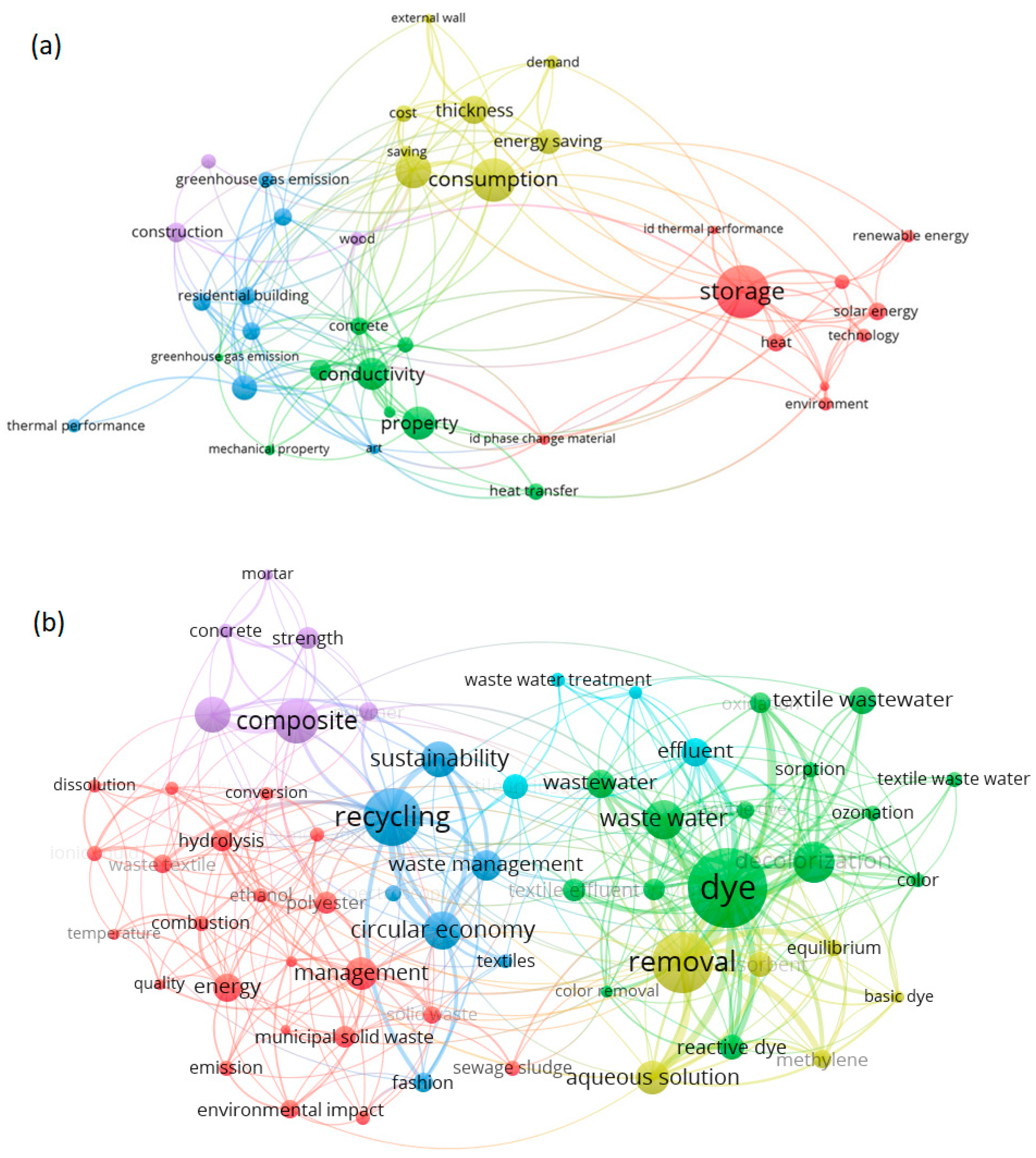


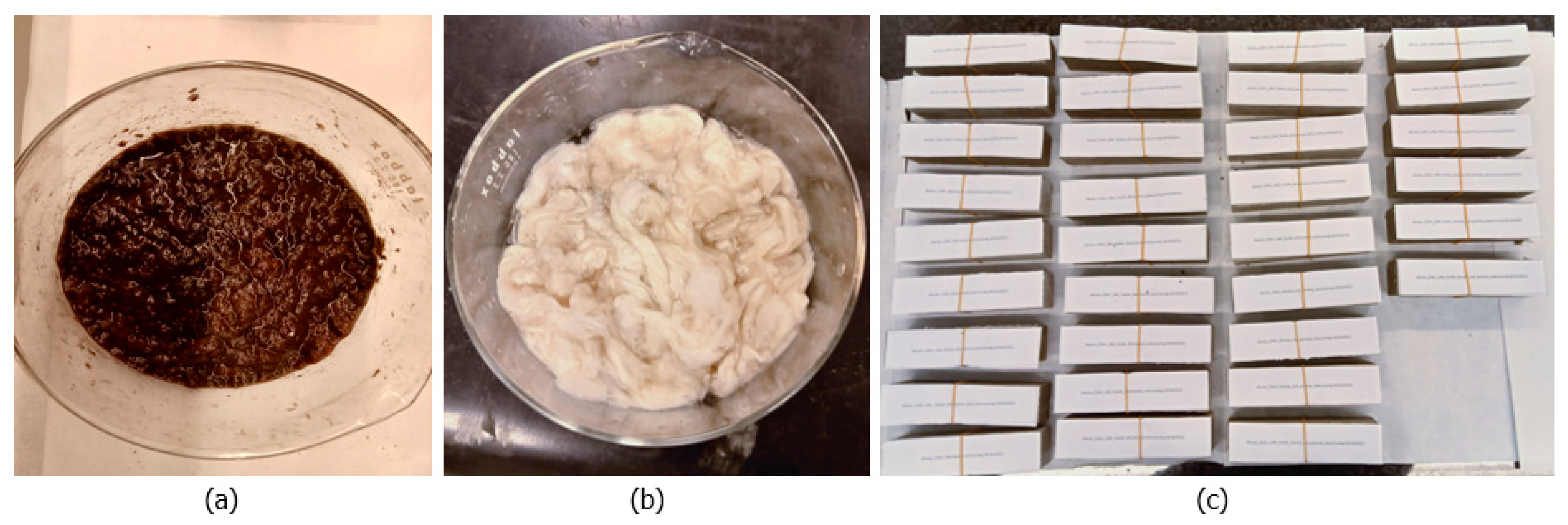

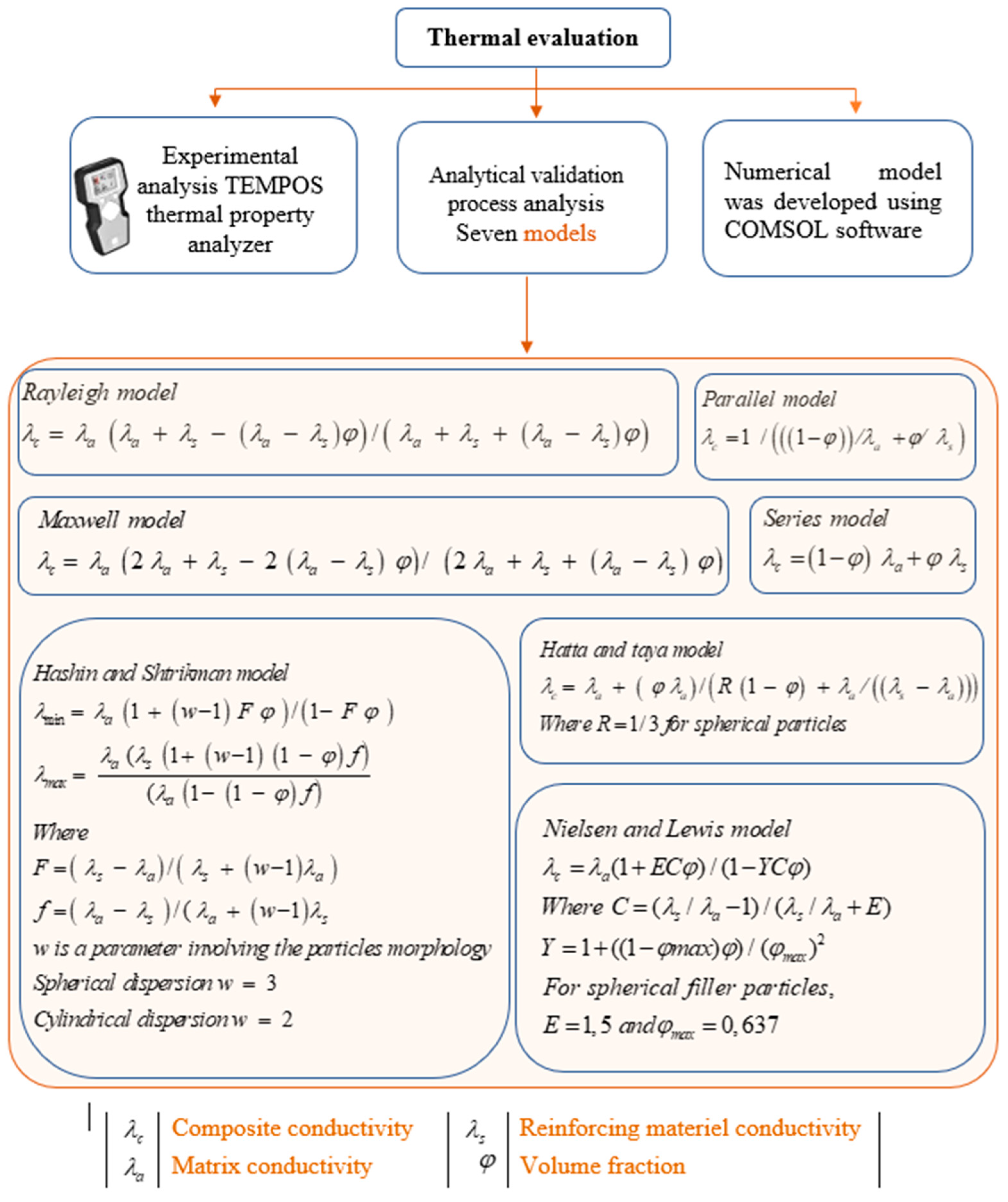

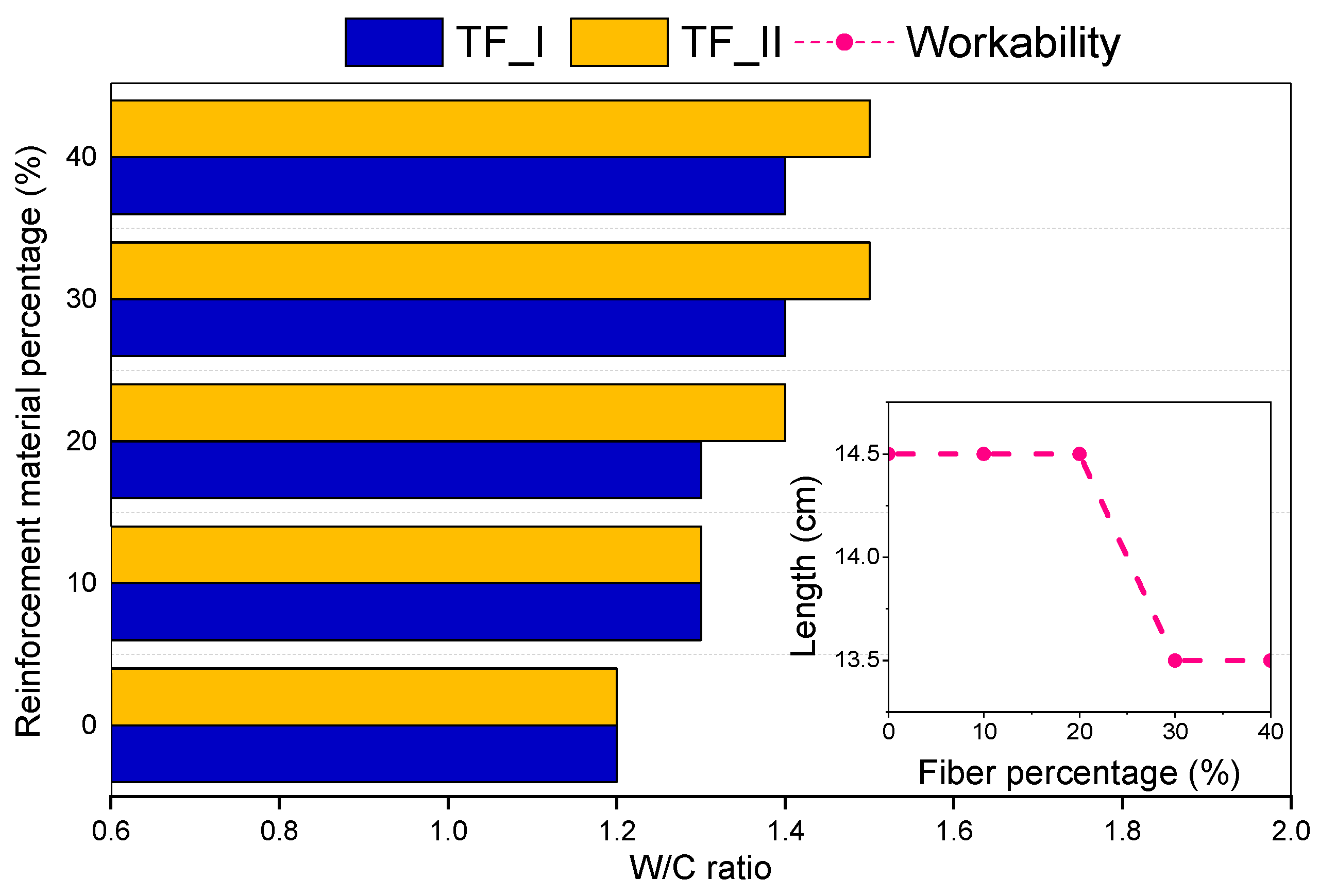

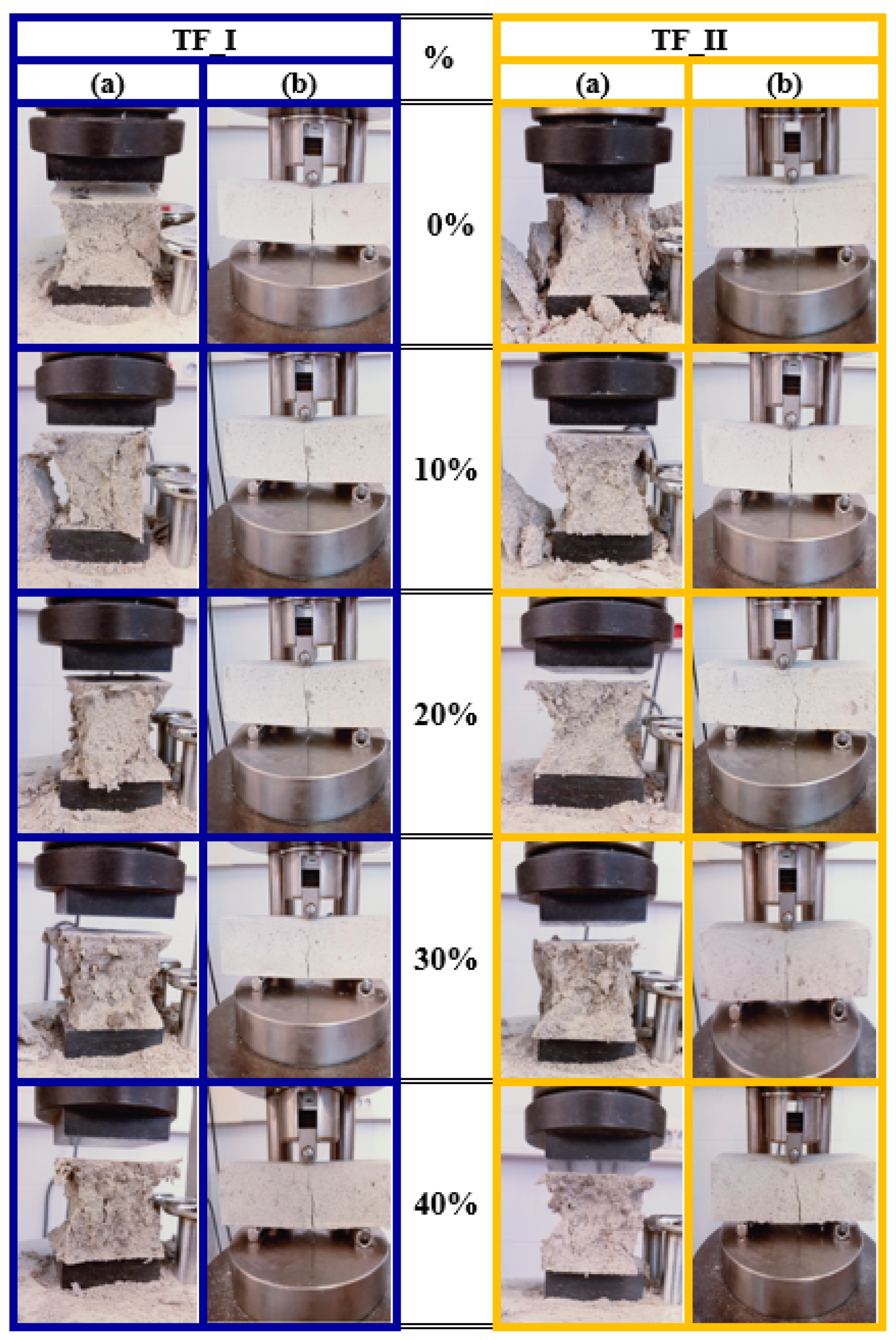
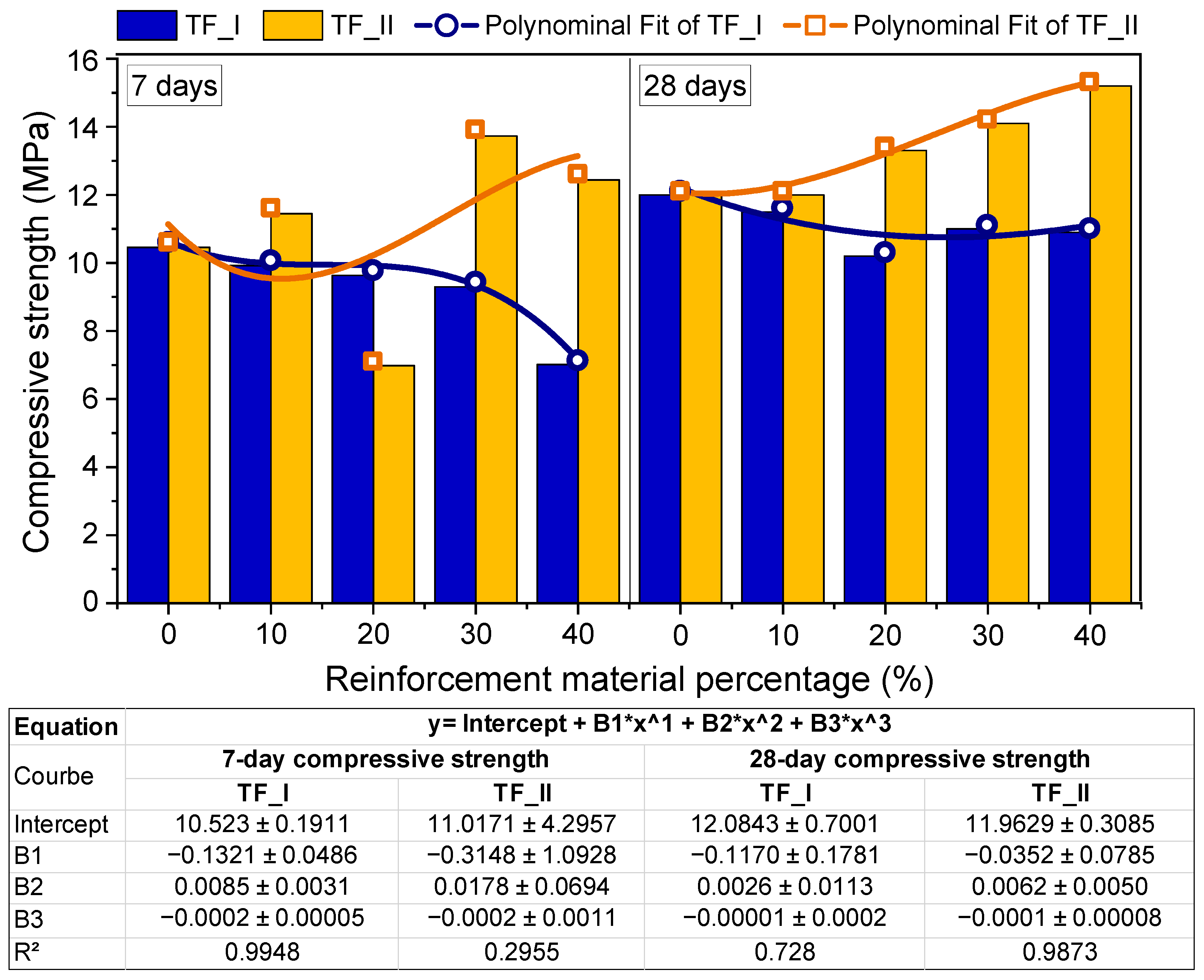

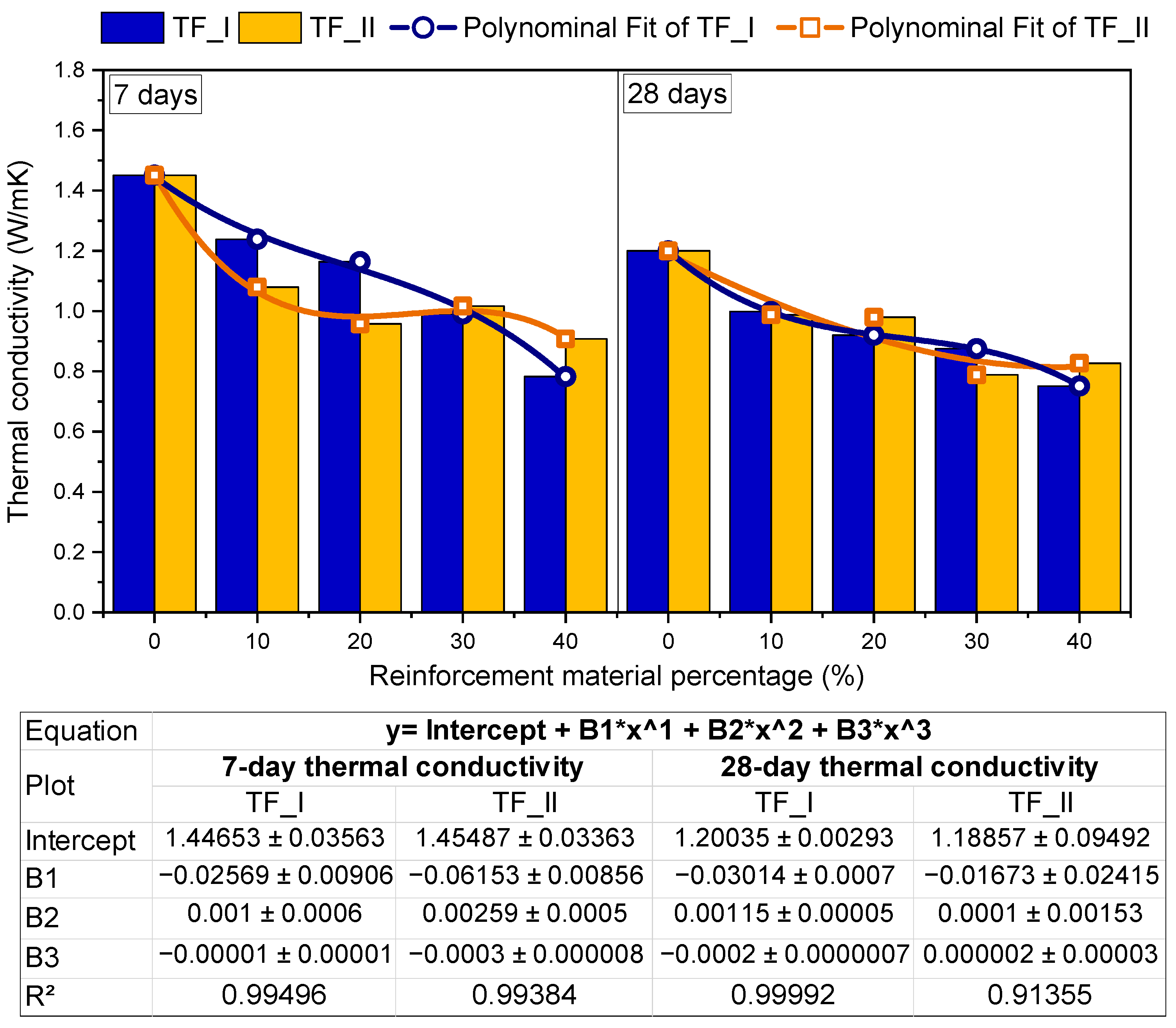


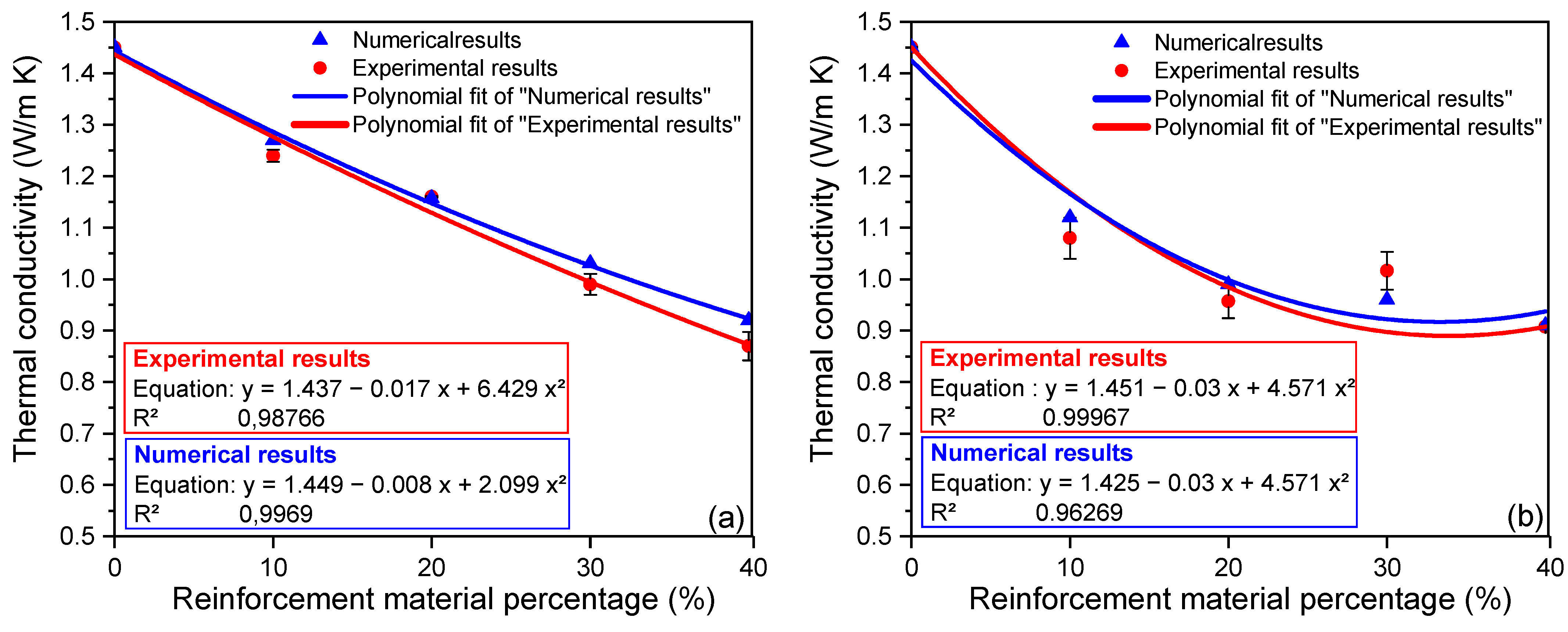

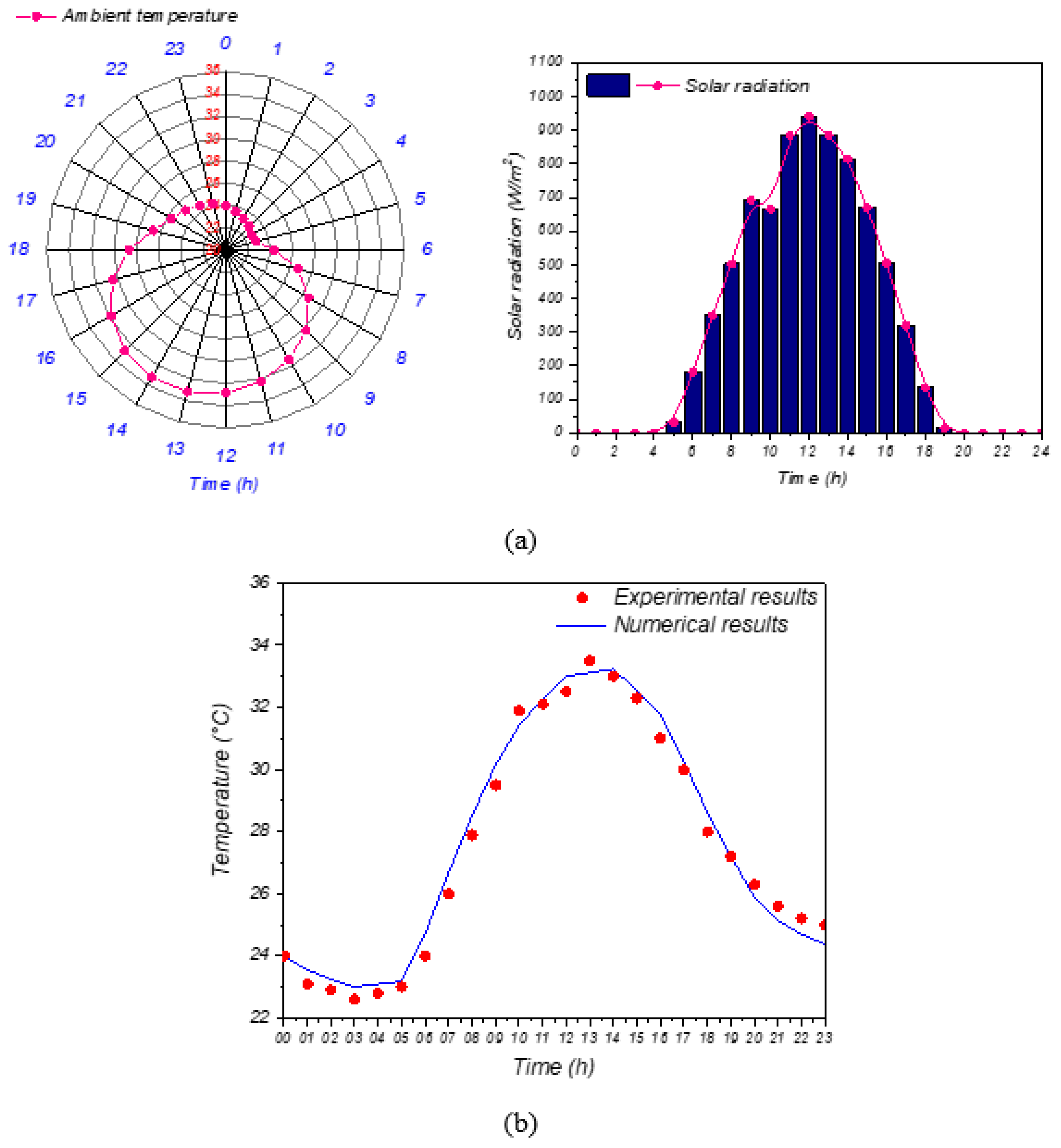

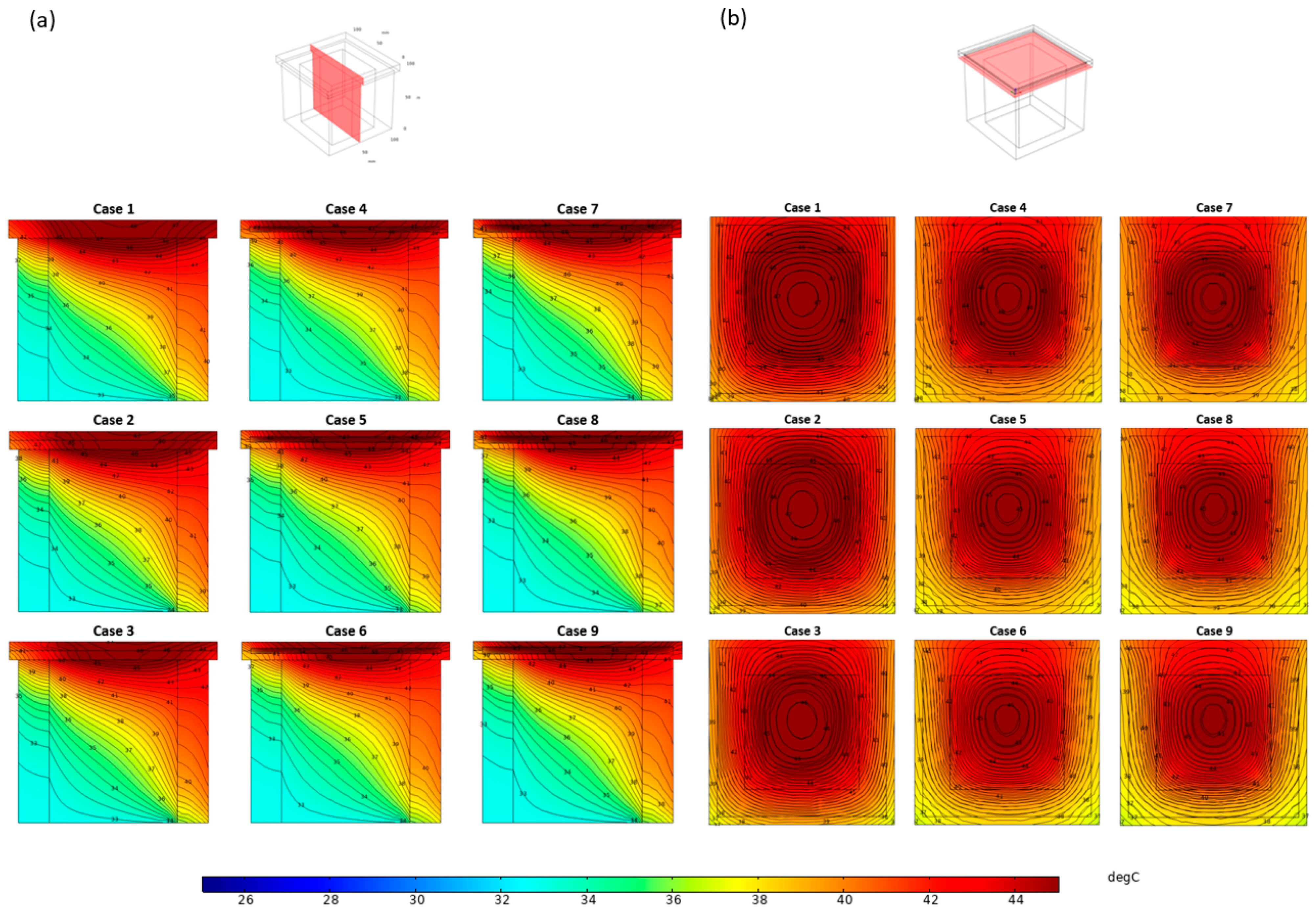



| Materials | Thermal Conductivity [W/m·K] | Thermal Diffusivity [mm2/s] | Volumetric Heat Capacity [MJ/m3·K] |
|---|---|---|---|
| Cement | 0.140 | 0.201 | 0.694 |
| Sand | 0.335 | 0.278 | 0.278 |
| TF_I | 0.082 | 0.418 | 0.196 |
| TF_II | 0.070 | 0.320 | 0.200 |
| Material | PCM DS5001X | Concrete |
|---|---|---|
| Thermal conductivity of solid [W/m·K] | 0.2 | 1.8 |
| Thermal conductivity of liquid [W/m·K] | 0.13 | - |
| Specific heat capacity of solid [J/kg·K] | 1700 | 880 |
| Specific heat capacity of liquid [J/kg·K] | 2153 | - |
| Latent heat [kJ/kg] | 130 | - |
| Density [kg/m3] | 995 | 2300 |
| Reinforcement Material | Replacement Percentage (%) | Thermal Conductivity (W/m·K) | Flexural Strength (MPa) | Compressive Strength (MPa) | Reference |
|---|---|---|---|---|---|
| Expanded polystyrene | [135] | ||||
| Rice husks | [45] | ||||
| Expanded perlite | [133] | ||||
| Juncus acutus | [136] | ||||
| Human hair | [137] | ||||
| Sheep wool | [138] | ||||
| Fiberglass | [103] | ||||
| Rubber granulate | [132] | ||||
| Fly ash | [139] | ||||
| Silica fume | [140] |
Disclaimer/Publisher’s Note: The statements, opinions and data contained in all publications are solely those of the individual author(s) and contributor(s) and not of MDPI and/or the editor(s). MDPI and/or the editor(s) disclaim responsibility for any injury to people or property resulting from any ideas, methods, instructions or products referred to in the content. |
© 2025 by the authors. Licensee MDPI, Basel, Switzerland. This article is an open access article distributed under the terms and conditions of the Creative Commons Attribution (CC BY) license (https://creativecommons.org/licenses/by/4.0/).
Share and Cite
Ayed, R.; Borri, E.; Skouri, S.; Lachheb, M.; Bouadila, S.; Younsi, Z.; Cabeza, L.F.; Lazaar, M. Experimental and Computational Assessment of Building Structures Reinforced with Textile Fiber Waste to Improve Thermo-Mechanical Performance. Buildings 2025, 15, 425. https://doi.org/10.3390/buildings15030425
Ayed R, Borri E, Skouri S, Lachheb M, Bouadila S, Younsi Z, Cabeza LF, Lazaar M. Experimental and Computational Assessment of Building Structures Reinforced with Textile Fiber Waste to Improve Thermo-Mechanical Performance. Buildings. 2025; 15(3):425. https://doi.org/10.3390/buildings15030425
Chicago/Turabian StyleAyed, Rabeb, Emiliano Borri, Safa Skouri, Mohamed Lachheb, Salwa Bouadila, Zohir Younsi, Luisa F. Cabeza, and Mariem Lazaar. 2025. "Experimental and Computational Assessment of Building Structures Reinforced with Textile Fiber Waste to Improve Thermo-Mechanical Performance" Buildings 15, no. 3: 425. https://doi.org/10.3390/buildings15030425
APA StyleAyed, R., Borri, E., Skouri, S., Lachheb, M., Bouadila, S., Younsi, Z., Cabeza, L. F., & Lazaar, M. (2025). Experimental and Computational Assessment of Building Structures Reinforced with Textile Fiber Waste to Improve Thermo-Mechanical Performance. Buildings, 15(3), 425. https://doi.org/10.3390/buildings15030425












